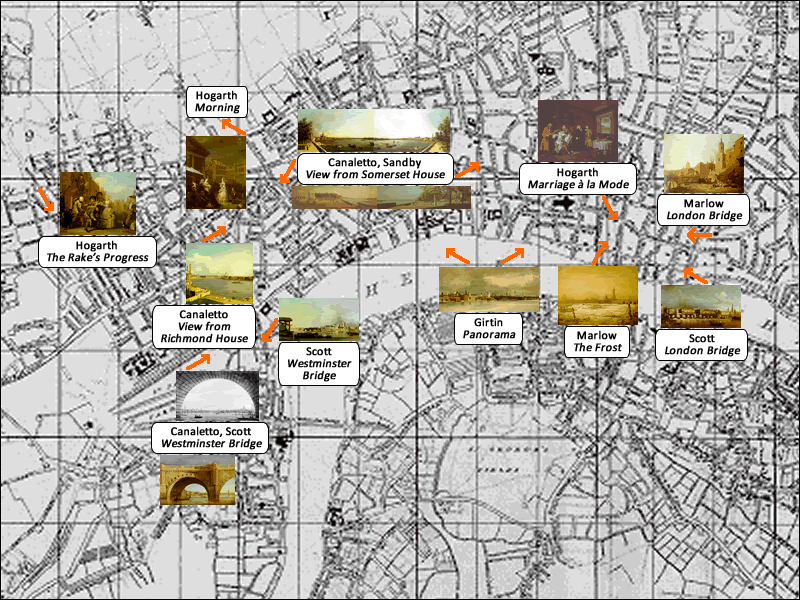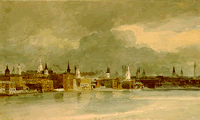The painters’view of London
The pictorial field of vision
The art of cityscape combines the selection of a point of view affording a well-composed vista with the sense of multiple directions and breadth of field proper to a metropolis.
It evolved in the 18th century with the successive pictorial practices which served to represent the field of vision :
Paintings show views of London from numerous complementary viewpoints, as shown on a map.
Central sections of Rocque’s map (1746)
Near the thumbnails of cityscapes, an arrow indicates the direction of the view.

- Canaletto View from Richmond House ,
- Canaletto View from Richmond House ,
- Canaletto View from Richmond House ,
- Canaletto Westminster Bridge ,
- Canaletto Westminster Bridge ,
- Canaletto Westminster Bridge ,
- Canaletto Westminster Bridge ,
- Canaletto, Sandby View from Somerset House ,
- Canaletto, Sandby View from Somerset House ,
- Canaletto, Sandby View from Somerset House ,
- Canaletto, Sandby View from Somerset House ,
- Canaletto, Sandby View from Somerset House ,
- Girtin Panorama ,
- Girtin Panorama ,
- Girtin Panorama ,
- Girtin Panorama ,
- Hogarth Marriage à la Mode ,
- Hogarth Marriage à la Mode ,
- Hogarth Marriage à la Mode ,
- Hogarth Morning ,
- Hogarth Morning ,
- Hogarth Morning ,
- Hogarth The Rake’s Progress ,
- Hogarth The Rake’s Progress ,
- Hogarth The Rake’s Progress ,
- Marlow London Bridge ,
- Marlow London Bridge ,
- Marlow The Frost ,
- Marlow The Frost ,
- Marlow The Frost ,
- Scott London Bridge ,
- Scott London Bridge ,
- Scott London Bridge ,
- Scott Westminster Bridge ,
- Scott Westminster Bridge ,
- Scott Westminster Bridge , )
London views reveal the sense of cityscape, above all in the views of bridges.
In the mid 18th century, the construction of Westminster Bridge, the second one after London Bridge, was represented by Canaletto and by Scott, whereas old London Bridge inspired Hogarth and Marlow who made views of it under unusual angles.
Several painters made companion pictures of the two bridges, the erection of the latter having emphasised the symmetry of the two cities of London and Westminster. Canaletto et Sandby painted views in both these directions from a single viewpoint on the quay, whereas Scott represented the two bridges each from a distinct point.
The later Blackfriars Bridge also became a place of interest : it is a focal point of Girtin’s panorama dating from the early 19th century.


